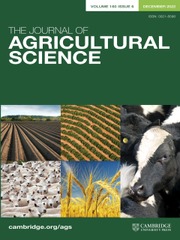Crossref Citations
This article has been cited by the following publications. This list is generated based on data provided by
Crossref.
Slafer, Gustavo A.
and
Andrade, Fernando H.
1991.
Changes in physiological attributes of the dry matter economy of bread wheat (Triticum aestivum) through genetic improvement of grain yield potential at different regions of the world.
Euphytica,
Vol. 58,
Issue. 1,
p.
37.
Slafer, G. A.
and
Miralles, D. J.
1992.
Green Area Duration during the Grain Filling Period of an Argentine Wheat Cultivar as Influenced by Sowing Date, Temperature and Sink Strength.
Journal of Agronomy and Crop Science,
Vol. 168,
Issue. 3,
p.
191.
Slafer, G. A.
and
Miralles, D. J.
1993.
Fruiting Efficiency in three Bread Wheat (Tritkum aestivum) Cultivars Released at Different Eras. Number of Grains per Spike and Grain Weight.
Journal of Agronomy and Crop Science,
Vol. 170,
Issue. 4,
p.
251.
Magrin, G.O
Hall, A.J
Baldy, C
and
Grondona, M.O
1993.
Spatial and interannual variations in the photothermal quotient: implications for the potential kernel number of wheat crops in Argentina.
Agricultural and Forest Meteorology,
Vol. 67,
Issue. 1-2,
p.
29.
Slafer, Gustavo A.
and
Andrade, Fernando H.
1993.
Physiological attributes related to the generation of grain yield in bread wheat cultivars released at different eras.
Field Crops Research,
Vol. 31,
Issue. 3-4,
p.
351.
Slafer, Gustavo A.
and
Savin, Roxana
1994.
Source—sink relationships and grain mass at different positions within the spike in wheat.
Field Crops Research,
Vol. 37,
Issue. 1,
p.
39.
Ortiz-Monasterio R., J.I.
Dhillon, S.S.
and
Fischer, R.A.
1994.
Date of sowing effects on grain yield and yield components of irrigated spring wheat cultivars and relationships with radiation and temperature in Ludhiana, India.
Field Crops Research,
Vol. 37,
Issue. 3,
p.
169.
Loss, Stephen P.
and
Siddique, K.H.M.
1994.
Advances in Agronomy Volume 52.
Vol. 52,
Issue. ,
p.
229.
Slafer, G.A.
Calderini, D.F.
Miralles, D.J.
and
Dreccer, M.F.
1994.
Preanthesis shading effects on the number of grains of three bread wheat cultivars of different potential number of grains.
Field Crops Research,
Vol. 36,
Issue. 1,
p.
31.
Murphy, D.P.L.
Dahab, M.H.
Wyseure, G.C.L.
and
O'Callaghan, J.R.
1994.
The simulation of the effects of shading on the growth and yield of winter barley (Hordeum distichum).
Computers and Electronics in Agriculture,
Vol. 11,
Issue. 4,
p.
347.
Slafer, G. A.
1995.
Wheat Development as Affected by Radiation at Two Temperatures.
Journal of Agronomy and Crop Science,
Vol. 175,
Issue. 4,
p.
249.
Savin, Roxana
Satorre, Emilio H.
Hall, A.J.
and
Slafer, Gustavo A.
1995.
Assessing strategies for wheat cropping in the monsoonal climate of the Pampas using the CERES-Wheat simulation model.
Field Crops Research,
Vol. 42,
Issue. 2-3,
p.
81.
Slafer, Gustavo A.
Halloran, Gerald M.
and
Connor, David J.
1995.
Influence of photoperiod on culm length in wheat.
Field Crops Research,
Vol. 40,
Issue. 2,
p.
95.
Miralles, Daniel J.
and
Slafer, Gustavo A.
1995.
Individual grain weight responses to genetic reduction in culm length in wheat as affected by source-sink manipulations.
Field Crops Research,
Vol. 43,
Issue. 2-3,
p.
55.
MITCHELL, R. A. C.
GIBBARD, C. L.
MITCHELL, V.J.
and
LAWLOR, D. W.
1996.
Effects of shading in different developmental phases on biomass and grain yield of winter wheat at ambient and elevated CO2.
Plant, Cell & Environment,
Vol. 19,
Issue. 5,
p.
615.
Mirallfs, D. J.
Domingufz, C. F.
and
Slafer, G. A.
1996.
Relationship Between Grain Growth and Postanthesis Leaf Area Duration in Dwarf, Semidwarf and Tall Isogenic Lines of Wheat.
Journal of Agronomy and Crop Science,
Vol. 177,
Issue. 2,
p.
115.
Kernich, G. C.
and
Halloran, G. M.
1997.
The Influence of Irradiance on Rate of Development and Components of Yield In Barley.
Journal of Agronomy and Crop Science,
Vol. 178,
Issue. 3,
p.
165.
Bindraban, Prem S
Sayre, Ken D
and
Solis-Moya, Ernesto
1998.
Identifying factors that determine kernel number in wheat.
Field Crops Research,
Vol. 58,
Issue. 3,
p.
223.
Landau, S.
Mitchell, R.A.C.
Barnett, V.
Colls, J.J.
Craigon, J.
and
Payne, R.W.
2000.
A parsimonious, multiple-regression model of wheat yield response to environment.
Agricultural and Forest Meteorology,
Vol. 101,
Issue. 2-3,
p.
151.
Slafer, G.A.
Abeledo, L.G.
Miralles, D.J.
Gonzalez, F.G.
and
Whitechurch, E.M.
2001.
Photoperiod sensitivity during stem elongation as an avenue to raise potential yield in wheat.
Euphytica,
Vol. 119,
Issue. 1-2,
p.
191.

